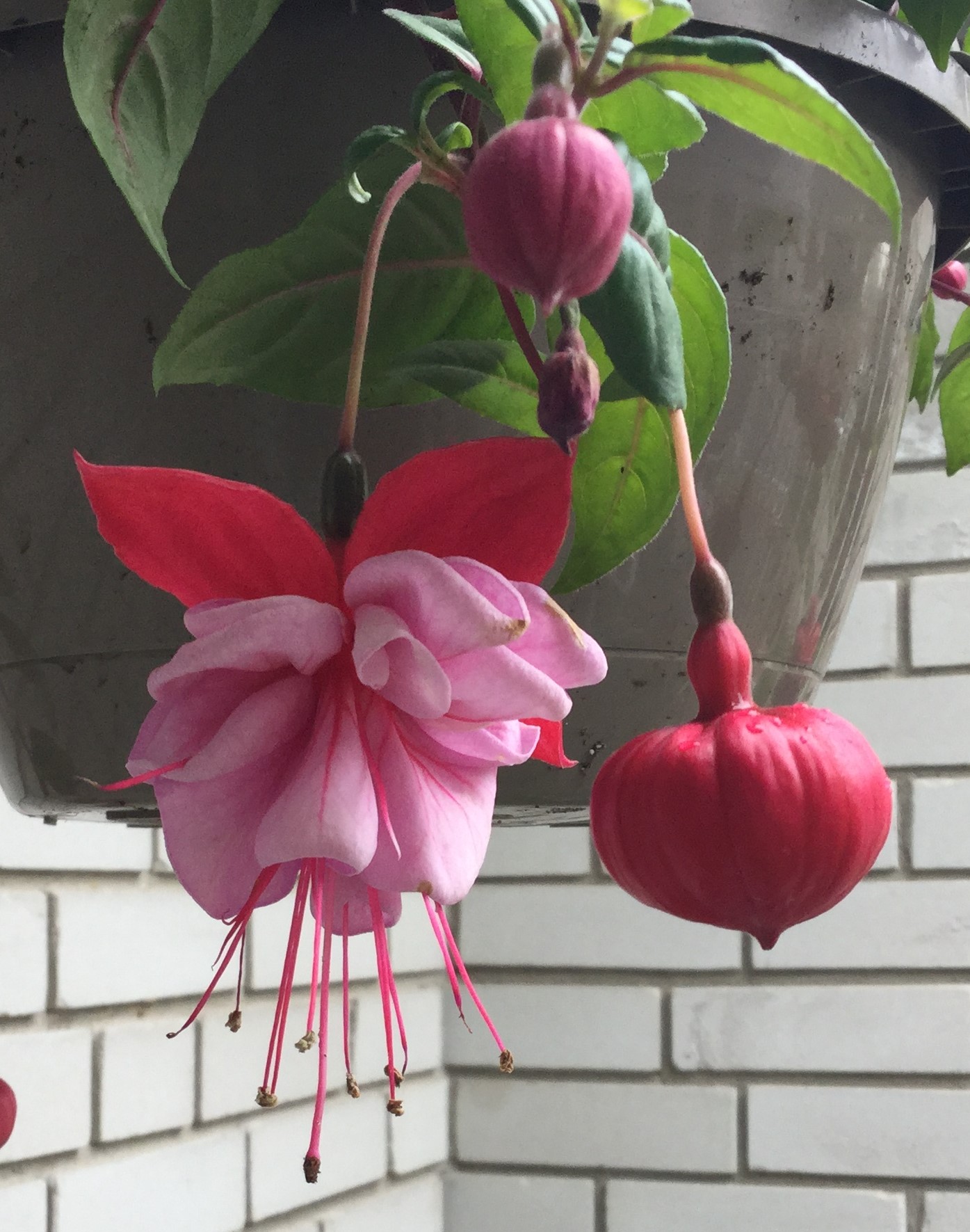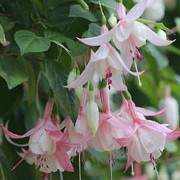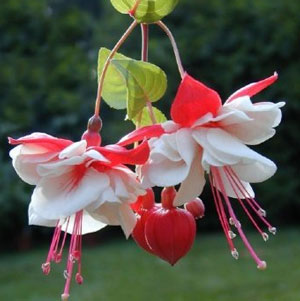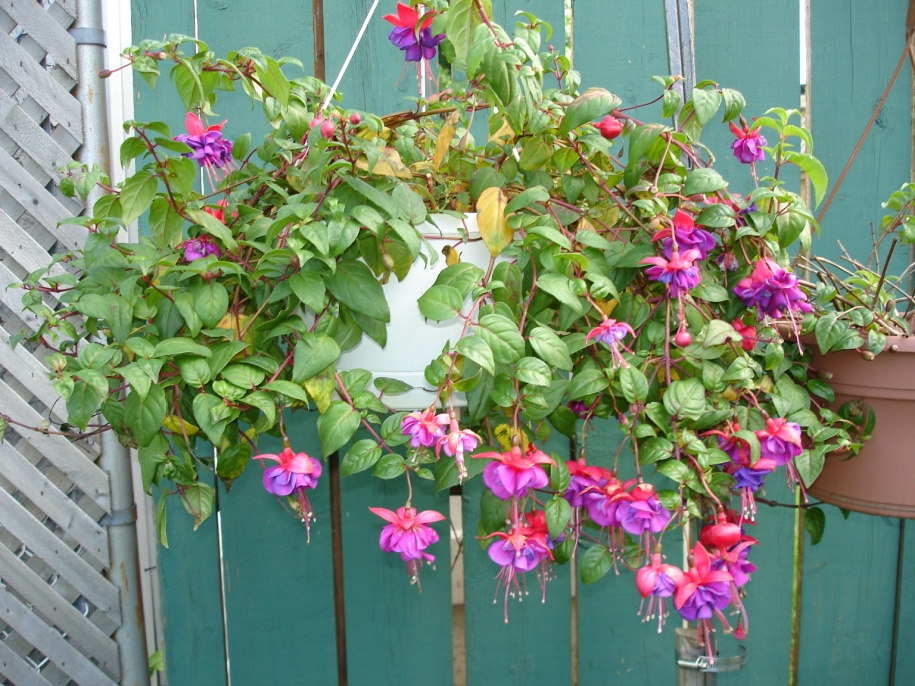Fuchsia Culture
Fuchsia Growing Info
By: Regina Plows
From: Oregon Fuchsia Society, Northwest Fuchsia Facts, December 1995
Light:
Fuchsias need lots of light to grow and bloom. Choose a location outdoors where the plants receive direct morning sun or filtered sun all day. The warmer the climate, the more shade will be necessary. Some small flowered pot plant varieties will also grow in a very bright window.
Temperature:
They perform best where the summer days stay below 85oF and the nights are cool. During hot and dry weather, frequent daily misting may be necessary. The majority of Fuchsias are damaged by prolonged sub-freezing temperatures. Hardy cultivars can survive temperatures in the teens as long as they are planted deep, well established in the ground and heavily mulched.
Soil And Feeding:
Plant Fuchsias in humusy soil in the garden or use a light organic planter mix in containers with perfect drainage. Wooden containers or fiber pots keep the roots cool and allow the plants to ‘breathe’. Clay pots do the same but dry out faster. Apply balanced fertilizer during the growing season. Feed container plants at least bi-monthly if water soluble fertilizer is used. Fuchsia are greedy feeders. Increase phosphorous while they bloom, but do not omit nitrogen entirely.
Pruning:
Prune heavily in late winter or early spring, when the danger of frost is passed. Remove dead wood and most of the previous year’s growth. Roots of container plants may also be pruned at this time. Start feeding as soon as green growth appears. Pinch out growth tips repeatedly for bushier plants and more blooms. Flowers will open 6 to 8 weeks after pruning is stopped. Pick off berries to prolong the blooming season. In cold winter areas, withhold all fertilizer in the fall to harden off plants before they go dormant for the winter. Most Fuchsias need long days to flower. Some varieties, notably the triphylla hybrids, can be in bloom all year long if the climate is mild.
Water:
Fuchsias like their roots moist but not soggy wet. Water when the surface of the growing medium becomes dry. A container plant in full bloom needs water once a day or possibly twice in very warm and dry weather. Do not water a wilted plant in the midday heat if the soil is still wet. You may suffocate the roots! Mist the leaves to reduce surface temperature and move the plant to a cooler location.
Training:
Fuchsias can be trained as a bush, tree, basket or espalier in accordance with their natural growth habits.
Pests:
White fly, thrips, and red spider mites can do occasional damage. Check your local nursery for remedies recommended in your area.
Care of

A pinching program should be started along with the feeding program. There is a concentration of growth hormone in the tips of the growing plants. The effort of pinching is to redirect the supply of this growth hormone to the growing tips below the pinch. The pinch is made just above a node, preferably one where lateral branches are beginning to develop. In hanging fuchsias or standards, you may safely pinch after two pairs of leaves have formed for the first several times. As the laterals break over the edge of the container, you can stop pinching, thus permitting long sweeping branches to form. It takes 6 to 8 weeks for fuchsias to come into full bloom from the time of last pinching so timing is very important if the plants are being grown for a show. Since all fuchsias do not grow the same, they are not trained the same. When the branches become long enough and show that they need to be pulled down, weights placed along the branch will pull them down until they grow in the desired position, and the weight of the blooms hold them down. Training becomes the principal for those who lean toward growing fuchsias in special shapes such as rings, espalier, trellis and standard.
Fuchsias are known to be heavy feeders. This is true of container grown fuchsias in particular. Soon after new growth appears and the new roots have begun to develop, a regular feeding schedule should be started. The first couple of feedings should not be greater than half-strength to avoid damage to the tender roots. As more growth appears, more food is needed. Fuchsias like to be fed often. Some growers have good results by fertilizing lightly at each watering. Various types of fuchsias have different food requirements. For plants such as hanging baskets and standards, a fertilizer high in nitrogen should be used at first. Uprights do not require as high a nitrogen content, so a balanced fertilizer would be ideal. As growth increases, continue regular applications of fertilizer, but do not make it any stronger than the manufacturer recommends. A dry plant should never be fertilized. To do so will injure the roots, and possibly kill the plant. When the plant starts blooming, decrease nitrogen and increase potash as a bloom booster.
The notion that fuchsias are “shade plants” is erroneous since not many fuchsias will tolerate deep shade. A certain amount of sun is important and beneficial for all fuchsias and some will tolerate full sun. This also will vary between plants grown in containers and in the ground. Most fuchsias respond to full light as contrasted with full sun. Light, filtered through a high fog, seems to be, to a fuchsia’s liking. Since it is usually cool in foggy areas, it takes longer for the fuchsia to bloom. In less foggy areas, filtered light will give best results. Filtered light is achieved by growing fuchsias under trees or structures, but be sure that the tree is not so dense that it casts deep shade.
While the days are short and the sunlight is fairly weak, the plant can be placed in full sun to spur new growth. While the pinching program is in progress during the late spring, keep in mind that the more light a plant gets, the shorter the distance between pairs of leaves along the stem. If you want to get long sweeping limbs on a basket or standard, you should give it more shade. Bushes, however, can use as much light as possible during the whole season.
The number of plants to put in a basket depends on how big the basket, how large the plant, and how vigorous the plant grows. Some plants are able to fill a basket quickly with one plant while others need many plants to do the job. One small plant, alone in a basket may not be able to absorb all the moisture available, and may simply drown. Many growers will place 3 plants in the centre of a 10″ or 12″ basket early in the season. This tends to fill the centre of the basket better than if the plants are placed toward the outer rim. Pruning, training and pinching should then be done toward the outside of the basket.
Submitted by Glen Cox from an unsigned article found in the April 1993 and Jan. 2001 Eugene Fuchsia Society Newsletter and the April 2010 BC Fuchsia & Begonia Society Newsletter.
Overwintering
From Puget Sound Fuchsia Society Newsletter, September, 2002
It’s during the winter that most growers lose plants. The two vital overwintering points are that plants must be kept frost free and must never be allowed to dry out. As autumn approaches, branches and shoots on your plants will ripen and harden into firm brown wood, preparing for their winter rest. Plants withstand the winter much better with ripe wood than with young green sappy growth. To induce your plants to become dormant gradually reduce watering in September and October. Discard plants which did not come up to your expectations. Remember you need storage space.
The Fuchsia is a deciduous shrub and needs a few months rest during the winter. After that it’s necessary to prune the wood. As a Fuchsia grower, you are faced with two alternatives for pruning. Some growers prune in the autumn and some favour the winter or very early spring. One disadvantage of autumn pruning is that unless the wood is completely ripened, you are pruning green sappy growth and dieback will follow.
Where do we prune? First we cut away all dead and spindly growth, especially all misplaced branches and those growing over each other to open up the plant. Adopt the principle of cutting away approximately two-thirds of last year’s growth, or to describe this in another way, prune back to one or two eyes on each lateral.
Baskets with old plants need hard pruning, to prevent a bare centre. Outside hardies are not pruned until new growth appears in the spring from the base of the plant. Standard Fuchsias should be pruned back rather hard in order to obtain more branching near the head.
The end of January or beginning of February is an ideal time to start spraying your stored plants with clear tepid water. Spraying softens the wood and encourages formation of new pink eyes that help us by indicating where new shoots will come, enabling us to shape the plants.
Wake Up Time
By Glen Cox
By early February, your fuchsias that have been resting should be brought back into full light. The days are lengthening and the sun is stronger. The bare branches of your hanging baskets or pots should be showing signs of buds swelling and new leaves developing. It’s time to prune and re-pot.
Pruning & Pinching:

- For trailers, I usually cut the branches back to almost the rim of the pot or basket and those branches on the top of the plant receive a less vigorous trim to help keep the top full.
- For the upright varieties, reduce the height by at least one third on the strong growing varieties.
- For the lax growing varieties, prune back again by at least one third or more and nip out all the weak and crossing stems to create a strong framework.
- If you have baskets or containers with three to five plants in them and only one or two have survived the winter, I usually dismantle the basket and replant the good ones into separate pots and discard what is left.
- After all this pruning, your plants will have an uncluttered skeleton like appearance. After a few weeks, the new growth will start to appear and that is time to start pinching. Pinching is depended on growth habit. Some varieties have a short distance between nodes, some about 4 – 8 cm. and some longer (esp. trailers). A general guide would be to pinch about every third node on the close nodes, every two sets of leaves on the middle growers and on the longer nodes, every one to two full set of leaves. Most varieties have two leaves at each node but if you look carefully, you may find three leaves at each node on some plant varieties. These varieties with three leaves are usually good for store plants. When you pinch, the three send out three branches and when they are pinched, it’s possible to get nine branches on the second pinch. If you start early and are able to get a third pinch, you are on your way to a very full plant.
- It is important to remember to allow enough time to pinch the entire basket at the same time and then leave it alone until the next pinching.

Re-Potting:
- Fuchsias need some new soil for a new season. Remove the root ball from the basket – clean the basket and tease away much of the old soil from the top, sides and bottom of the root ball and root prune away broken or old straggly roots. Then put fresh compost in the bottom, replace the now smaller root ball and fill in around the edge. Your fuchsia should now be ready for a new season.
- If you are growing triphylla fuchsias and you wish to increase the foliage at the bottom of the plant, you may slice off 10 to 12 cm from the bottom of the root ball and then place it low in the container and put fresh compost on the top of the pot. This will encourage new branches to form from the main stem below soil level and eventually create a bushy plant.
Tips For New Fuchsia Cuttings:
Soil mix – two parts peat or sphagnum compost and one part perlite
- For tryphyllas, try to have two or three leaf nodes in the soil as the cutting develops, hopefully these leaf nodes will produce underground stems to make for a fuller plant.
- For all of your regular fuchsias, try small tip cuttings taken from your pruning.
- Use small pots or cell packs with the above mix, fill your containers, do not press the soil down, place in a shallow pan of water overnight and insert your cutting the next day. Keep the first set of leaves just above the soil level, label variety name and place in your propagator or in plastic tent or bag. Do not water from the top until new growth is evident. Cuttings should root in two to three weeks. Gentle bottom heat will speed up the process but is not necessary. Good light is required but no direct sunlight. You may need to ventilate a little with plastic bags or covers. Once rooted and new growth is evident, place in good light and ground cool. For sturdy plants, pinch out the growing tip of the cutting, once two or three sets of leaves have developed. As soon as roots have reached the outside walls, pot on to the next size pot.
Training Your Plants : Baskets
Reproduced from the British Fuchsia Society
Submitted by Glen Cox
One of the nicest ways of displaying fuchsias is by growing them in hanging baskets or pots. The full beauty of the flowers can be seen as one looks up into the hanging flowers.
Baskets are very easy to produce although a little forward planning is necessary. If it is possible to obtain young plants or take cuttings in the autumn then you will have excellent plants for flowering in baskets over a long season. Ideally, plants prior to placing in a basket should be growing in three and a half inch pots (9cm) and should have been stopped at least once, preferably twice. This will give you well branched plants what will rapidly fill the basket.
The number of plants you need for each basket depends upon its size. A twelve inch diameter basket will take four plants; a fourteen inch diameter basket can take five or six plants. It is recommended that you should always fill a basket with one variety of fuchsias only. A far more attractive display is given than if you should mix the cultivars. The reasoning behind this is simple in that varying cultivars have different speeds of growth and are likely to flower at different times. A good basket should be a mass of evenly grown foliage with an excellent covering of flowers over the whole of the basket.

There are many types of baskets available in the shops these days and all are very satisfactory. They all need to have good drainage facilities. The wire baskets will need a lining and for this purpose moss or a sheet of polythene are equally acceptable. If using plastic, ensure that drainage holes are pierced. Basket liners made of fibre or the cocofibre liners are extremely useful. Because of its greater lightness, peat based compost is ideal and if a long lasting fertilizer such as Osmocote is added it will be helpful.
To make up your basket, stand it in a large pot or bucket for ease of filling. Pour in a quantity of just moist compost so that you have a layer of approximately two inches. Get some pots of the same size as those within which your plants are growing and place them in position on the compost. Three or four around the outside of the basket and one in the centre will fill the basket with foliage later. You may, if you wish, place them at a slight angle so that the plants will be overhanging the sides. Fill the basket and the pots with your compost. A tap on the bench will settle the compost and it will then be possible to remove the pots from the basket leaving you with a mound of the exact size needed for the root system of each plant. Remove the plants from their pots and replace them in the molded form in the basket.
The earlier in the year you make up your basket the better it will be but you must not be tempted to place it permanently outside until all risk of frosts has passed. This could be early June. Whilst the plants are continuing to grow, and filling the basket with foliage, it will be necessary to continue “pinching out” the growing shoots each time three sets of leaves have been formed. This will give us very bushy plants and will rapidly completely cover the basket.

A half basket, sometimes called a wall basket, is ideal for breaking up the bareness of a wall. The same method of filling the basket is applied and it will be necessary to have three or four plants around the front and the sides of the basket with a further one in the centre.
Hanging pots usually available from 5 ½ (13 cm) diameter up to about 8 ½ (22 cm) are also very attractive and will need a smaller bracket to bring them away from the wall. The smallest of these hanging pots can be filled with one well grown plant but the larger pots are more attractive if two or three plants are used.
Feeding should be carried out on a regular basis and an eye should be kept open for any pests. The watering of baskets can be a nightmare as they will be completely open to strong sun and the wind. During very hot spells, it might be necessary to water these containers twice a day.
Hanging baskets, wall baskets and hanging pots always look very attractive. I have suggested growing fuchsias, only, within your hanging baskets and this is necessary if you intend to display your baskets in Fuchsia Shows. However, fuchsias can be used with other kinds of hanging plants. Each will complement the other. Ivy leaved Geraniums, Trailing Lobelia, Helichrysum, Impatiens, Begonias and many other plants all combine will with fuchsias and will provide a spectacle the envy of all who see them.
Recommended cultivars suitable for using in a basket are:
(Of necessity this is a very incomplete list – a glance at any specialist Fuchsia Nursery catalogue will give you the names of many other suitable cultivars.)
| ANNABEL: | Double, Sepals white, Corolla white flushed pink. |
| ANTIE JINKS: | Single, sepals white edged cerise, Corolla purple with white shading. Smallish flowers but very floriferous. |
| GOLDEN MARINKA: | Single, Sepals deep red. Corolla slightly deeper red. Foliage variegated green and yellow with red veins. Requires maximum sunlight to bring out colour from the leaves. |
| HARRY GRAY: | Double. Sepals white. Corolla white slightly flushed pink. Small flowers profusely produced. |
| JACK SHAHAN: | Single. Sepals rose Bengal. Corolla rose pink. Superb cultivar producing flowers in profusion. |
| MARINKA: | Single. Sepals red. Corolla dark red. An excellent cultivar producing abundant flowers over a long period. |
| PINK GALORE: | Double. Sepals pink with green tips. Corolla soft rose pink. |
| PINK MARSHMALLOW: | Double. Sepals pale pink. Corolla white with pink veining. Large blooms freely produced. |
| SWINGTIME: | Double. Sepals scarlet. Corolla pure white with scarlet veining. One of the most popular cultivars for this type of growth. |
 ANNABEL
ANNABEL PINK GALORE
PINK GALORE PINK MARSHMALLOW
PINK MARSHMALLOW SWINGTIME
SWINGTIME



